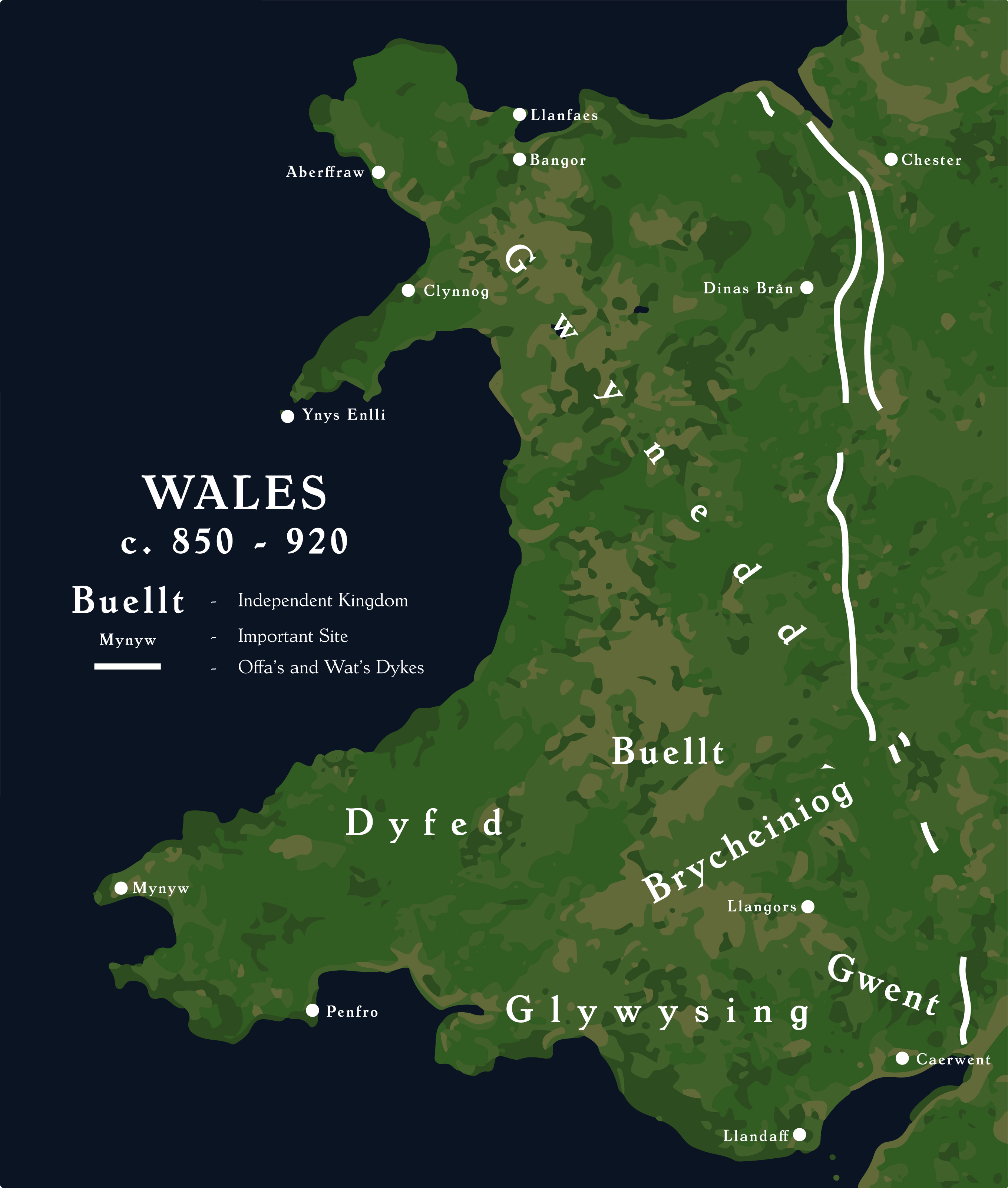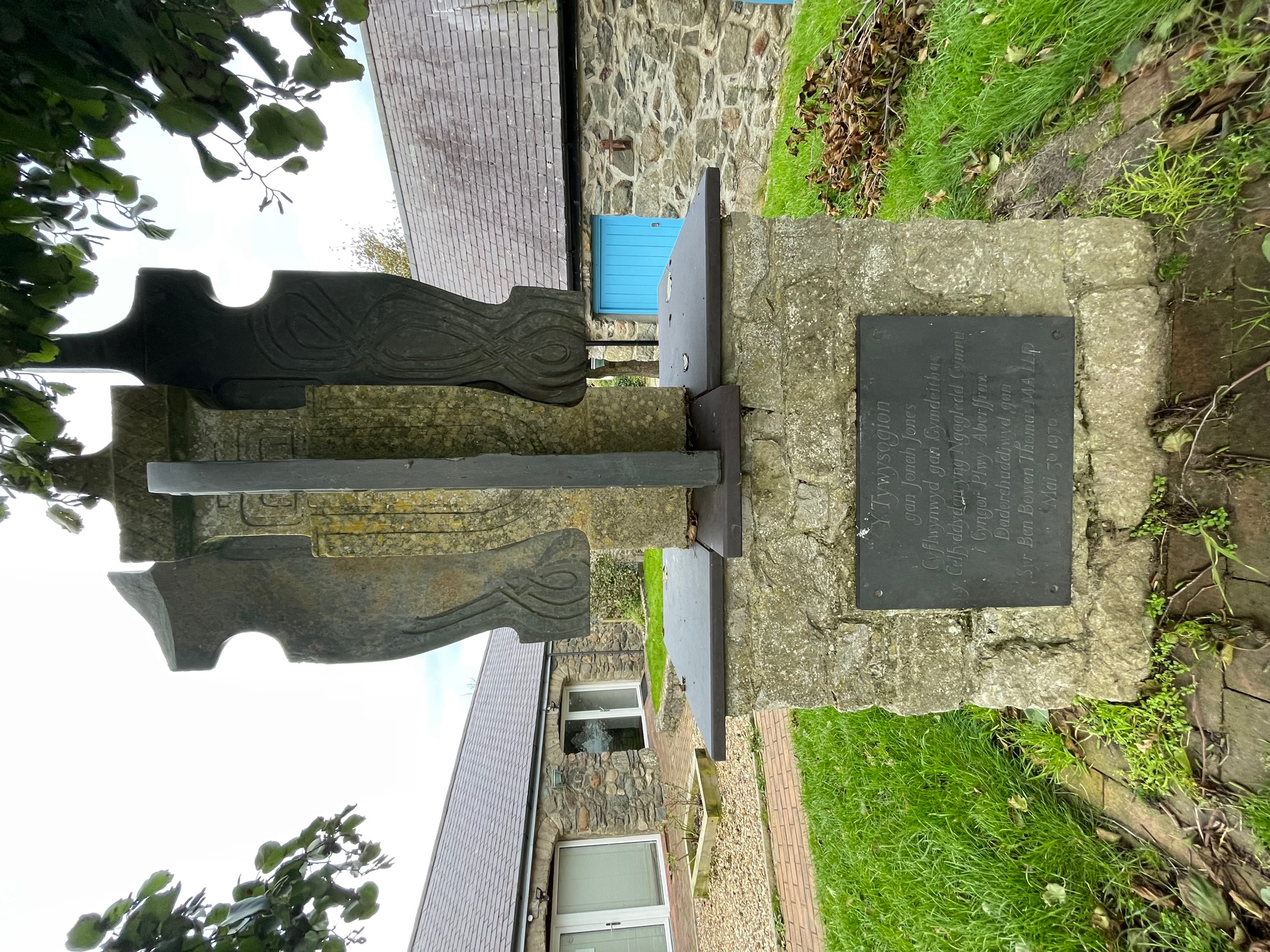Founding the Royal House of Aberffraw
Explaining the founding of the Royal House of Aberffraw (Second Dynasty of Gwynedd), its position in Wales as the preferred family seat, and Aberffraw's significance as a settlement for the Kings of Gwynedd. (Wikipedia articles linked).
The concept of a royal house or dynasty in Wales stems from the idea that a Kingdom would have a preferred location to dwell as a royal palace. But in Welsh Kingdoms there were many royal courts (llysoedd in Welsh), of all the residences in the kingdom, one of them would be the preferred chief location (modern capital) connected to the royal house and its family associated with the dynasty, e.g. House of Windsor of the United Kingdom and their preferred family seat Windsor castle, although the residence is owned by the crown and is not privatised. A family seat is a permanent settlement for a noble to surround himself (or herself) with family and friends or an entourage, and to come and go as they pleased. In this case, the Kingdom of Gwynedd had one preferred residence as a royal court, and that would act as capital (family seat). There were several different capitals in medieval Gwynedd between the 5th and 13th centuries: Chester (the Roman city of Deva Victrix in England) has been debated as the first capital, then Deganwy, Dindaethwy (Llanfaes), Aberffraw, Rhuddlan and finally Abergwyngregyn. The court at Aberffraw, Anglesey became the principal seat out of the dozen or so courts and thus started the Second Dynasty of Gwynedd, known as the House of Aberffraw (Talaeth Aberffraw in Welsh) in the 9th century named after the town it was based. The court was located as a formal residence to represent the family as their primary chosen location within their kingdom. In Wales, kings would rule kingdoms, and they would often move between courts (towns) within their realm. However, the significance of the royal house was that it acted as a cadet branch to the royal family to raise a family (cadet today used as a term for juniors). In this case, Aberffraw was the preferred court (Llys in Welsh) in Gwynedd. However, Aberffraw was the favorite royal court not just in the Kingdom but was also known as the preferred location for touring Kings from other Welsh royal houses, namely the House of Dinefwr in Deheubarth, and the House of Mathrafal in Powys.
 |
| Image courtesy of Wikimedia Commons, attributed to Lemonaurhywiol, map of Wales c. 850-920, pre-royal houses. |
The purpose of creating royal houses in Wales lies in the wording because the royal court acted like a modern-day lawmaking system. However, originally a Llys was an enclosed open space, which gradually changed meaning to become a place where legal issues took place. In Wales, there were three royal houses (Welsh y tair talaith/talaeth), represented by three crowned Princes (tri Tywysog Talaethog), because the 3 Princes wore a gold coronet each representing their status as rulers, a practice in effect for a millennium and still today for the Prince of Wales coronet. Perhaps it was a concept of the Prince of Wales's feathers, the heraldic badge of the Prince of Wales. Although the feathers emblem was brought by the Normans from France. The royal houses effectively split Wales into three distinct regions the North of Wales governed by Aberffraw from the Kingdom of Gwynedd, Mid Wales was governed by the Mathrafal from the Kingdom of Powys, and the South of Wales was governed by Dinefwr from the Kingdom of Dehebarth. It was Rhodri the Great (Rhodri Mawr in Welsh) as the King of Wales divided the country into three ruling Kingdoms inherited by some of his sons, namely; Anarawd got Gwynedd, Cadell got Deheubarth and Merfyn, Powys. The House of Mathrafal was formed centuries after the other two as a cadet branch of the House of Dinefwr. The plan in place was that if there was a dispute between two royal houses, then the third would act as an intermediary between the both to decide on the fate of the problem at hand. Therefore, if there was a problem on the borders between Gwynedd and Powys in North Wales, they would meet at Morfa Rhianedd on the banks of the River Dee and the Princes of South Wales of the House of Dinefwr would determine the outcome of the dispute. Then, if a dispute would arise on the borders of Powys and Deheubarth in Mid Wales, they would then meet at the White Palace (Llys Wen) on the River Wye, and the dispute would be decided by the House of Aberffraw from North Wales. These laws were put in place by Rhodri the Great for his sons and their descendants. That concept of hegemony is now the same way modern courts of law solve disputes between separate parties (but less violent!).
Formally the residence of Aberffraw was first established as a royal residence as early as the 5th century. The location for a new palace was founded by the Kings of Gwynedd who had battled the Irish Picts, a Celtic tribe that had settled in Anglesey after the dissolution of the Roman Empire. The Picts invaded post-Roman Brythonic Britain after losing the fortified defenses which kept foreigners at bay. The same situation happened in northern England, where Scottish Picts took advantage of the retreating Roman legions and invaded the country south of their border. This led to the Anglo-Saxon settlement of Britain, which began as a recruitment of people to help defend Britain, but it ended as another invasion, but that time from the south, on the European continent.
 |
| Artwork dedicated to the Princes of Gwynedd at the former 'Llys Llywelyn' heritage centre at Aberffraw on Anglesey. |
Anglesey's Aberffraw palace was built in the 5th century by Cadwallon Lawhir, King of Gwynedd. But, there are no remains of a palace from the 400s, nor a Roman settlement before that at Aberffraw. There was in fact only a sherd of pottery which was carbon dated to between the 27 to 387 AD, from the Roman period. However, the site of the royal court was actually proven to be a pre-historic settlement with a location in the vicinity at Aberffraw Bay dated to 7000 BC, also with Neolithic, Bronze, and Iron Age settlements found nearby. This proves a continuous inhabitation at Aberffraw for thousands of years. A location excavated (of 2 in Aberffraw) was found to be a royal court (Llys) and was identified as a medieval residence lived from the 9th century onwards, under the tutelage of the House of Aberffraw. Therefore the palace of Cadwallon remains a mystery. But like we saw on later castle building projects on Anglesey, the building materials were used from the previous Llys for a new castle in the 13th century, therefore it is likely the original medieval building materials were recycled, and maybe even on the very same location at the 5th century Llys.
It was Rhodri the Great who in 873 had built (rebuilt?) a royal palace at Aberffraw. Rhodri's eldest son Anarawd would inherit the Llys in the 9th century, and he founded the dynasty known as the Royal House of Aberffraw. From the era of the Lords of Aberffraw, the kings were protected their Seneschals (Chief councillor, similar to Prime minster). Rhodri's Seneschal was Marchudd ap Cynan, the Lord of Rhos. Marchudd's descendants continued their position as protectors of the king until the dissolution of medieval Aberffraw, and specifically the era of Ednyfed Fychan in the 13th century, when he served Llywelyn the Great and his son Dafydd ap Llywelyn (David II). Ednyfed's family also served Llywelyn's grandson Llywelyn II, and they later fought for Glyndwr during the Welsh War of Independence in the early 15th century. Then, Ednyfed's descendants became known as the Tudors of Penmynydd, who were ancestors to the Tudor Kings of England and Princes of Wales.
By the year 914, it was recorded that Aberffraw would have had 35 individuals working in the royal court, with an additional 12 armed horse-guards patrolling. There were rules written as codes of the house for all the associated people to abide by. They were documented from the 13th century, it was when the rules of the royal suite were reenacted by Llywelyn the Great and his wife Siwan, Lady of Wales and the illegitimate daughter of King John of England.
 |
| The excavated remains of Llys Llywelyn, the replacement of Llys Aberffraw near (5 miles) Newborough, Anglesey. |
 |
| Image courtesy of Wikimedia Commons, attributed to Sean Kisby, Llys Llywelyn reconstruction in St. Fagans Museum, Cardiff, South Wales. |
The royal household's opulence is in view today with the current Prince of Wales, himself a descendant of Llywelyn the Great of Aberffraw. Before then, the palace was abandoned and its roof collapsed by the 11th century, that was because of the Norman invasion. A Norman knight had built another residence, this time a stone castle on Anglesey at Aberlleiniog, where the Earl of Chester vied to control the small island through warfare. The Kings of Gwynedd would capture the castle and use it as their residence. But for a matter of centuries, Llys Aberffraw became the capital and controlling settlement of all Wales from Anglesey. The family would go on to dominate Wales through warfare until the 13th century, and would later emerge in Britain as the House of Tudor, England. They too in their own right dominated the landscape of Britain for centuries which evolved into the House of Stuart in Scotland, and finally from them came the Jacobites. Jacobitism began in the UK and spread to Europe, they unified families in different countries through the union of marriage. Examples of royal families apart from the British monarchy which are part of the current-day Jacobite succession include, the former Kingdom of Bavaria in Germany and the former Dukedom of Modena and Reggio in Italy.

Comments
Post a Comment